What’s a colon?
Stack two periods on top of each other, et vóila! A colon :
Study to acquire a habit of thinking: no study is more important.
I have three favorite fruits: apples, bananas, and mangoes.
He was tired: he stayed up all night.
If you want to succeed: you need to work hard.
How to use a colon
“The limitation of armaments, the acceptance of arbitration as the natural solvent of international disputes, the relegation of wars of ambition and aggression to the categories of obsolete follies : these will be milestones which mark the stages of the road.” —P.C. Wren, English Grammar and Composition.
Compare these sentences:
1. The principal parts of a verb in English are: the present tense, the past tense, and the past participle.
2. Study to acquire a habit of thinking: no study is more important.
Both sentences show the correct uses of a colon, but the role of the colon differs between the two. They both have two independent clauses (or sentences that can stand on their own) but the first sentence uses a colon to introduce items in a list.
The second sentence works different: here, the colon signals a deeper relationship a colon to signal a bond between the clauses, in that the relationship between the clauses, and elaborate or add emphasis on the information the clause that precedes the colon, with the clause that comes after it. Therefore, the colon is used primarily to introduce a list or series in sentences, or to connect closely related clauses by adding emphasis or elaborating on the information that precedes it with the information that follows it.
Colons used in sentences examples
Examples of colons in sentences:
1. I need a few items at the store: clothespins, a bottle opener, and napkins.
2. She has three dogs: two poodles and a beagle.
3. The American flag has three colors: red, white, and blue.
4. I need an assistant who can do the following: input data, write reports, and complete tax forms.
5. He got what he worked for: he really earned that promotion.
What’s the difference between a colon and a semicolon?
Answer: semicolons are used to connect two closely related sentences without coordinating conjunctions or commas. Colons signify a deeper relationships between the clauses, and either expands, adds emphasis or introduces a list.
Practice using the verb in different tenses with example sentences to memorize the correct forms.
Origin of the colon
The word ‘colon’ originates from the Latin and Greek languages: from Latin colon “part of a verse or poem,” from Greek kōlon “part of a verse,” literally “limb, member”.
In Review
Colons are used in sentences to:
1. Introduce a list or series;
2. Connect closely related clauses by adding emphasis or elaborating on the information that precedes the colon with the information that follows it.
Worksheet
According to the blog post, what is one of the primary uses of a colon?
How does the blog post differentiate a colon from a semicolon?
When connecting two closely related clauses, the post states a colon can be used to signal a deeper relationship and:
The blog post describes a colon visually as:
Based on the examples provided for introducing lists, the colon typically follows:
Choose the correct punctuation to introduce the list: I need a few items at the storeclothespins, a bottle opener, and napkins.
Fill in the blank with the punctuation used to connect these related clauses: Study to acquire a habit of thinkingno study is more important.
Choose the correct punctuation to introduce the list: The American flag has three colorsred, white, and blue.
Fill in the blank with the punctuation used to connect these related clauses: He got what he worked forhe really earned that promotion.
Choose the correct punctuation to introduce the list: I need an assistant who can do the followinginput data, write reports, and complete tax forms.
Frequently Asked Questions
What is a colon?
+
When is a colon used?
+
Can colons connect two clauses?
+
Can a colon introduce a list?
+
What’s the difference from a semicolon?
+
Yash, D. "Colons: A Guide on How to Use Colons, Plus Examples." Grammarflex, Jun 20, 2025, https://www.grammarflex.com/how-do-you-use-a-colon/.











